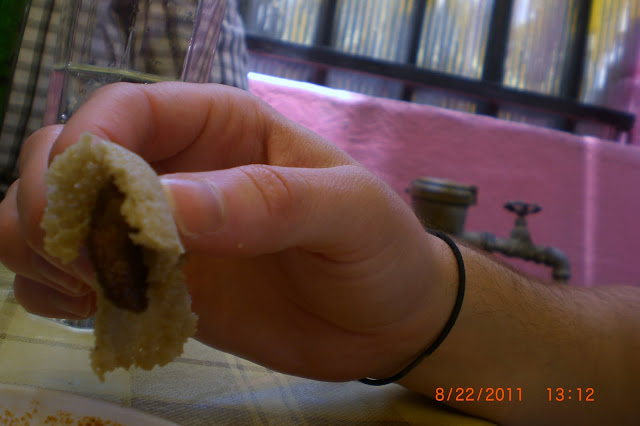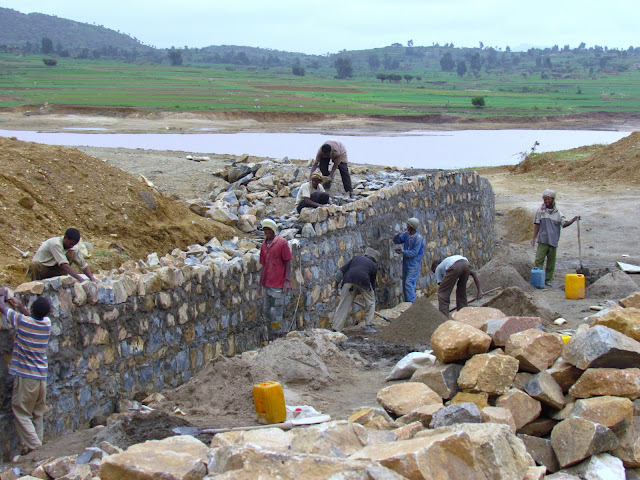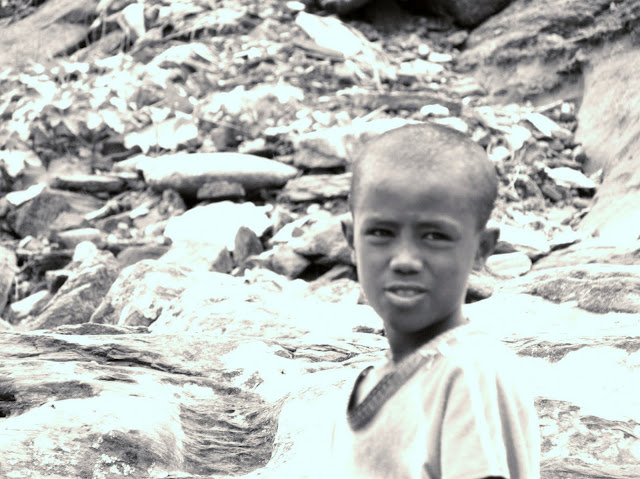This is my second consecutive blog entry that has been late. My initial goal was to write an entry every week; however, as time has gone on, it has seemingly gained some speed. My apologies again for my tardiness.
On 20 August the last PULSE Volunteer to join our team in Ethiopia arrived. Richard is joining us from a GSK-acquired company, Stiefel Research, in Melbourne, Australia. He left his wife and three kids in order to pursue this 6 months of service in Africa - something that has been on his Bucket List. He is a lot of fun, so of course we're happy to have him hanging with us here. His task is to better equip and set up laboratories in the Millennium Villages' Health Posts and Health Centers. He will be spending small stints of time in Addis Ababa at the Head Office, but will remain in Hawzien for the vast majority of his assignment. He's a rather adventurous guy, so he is definitely up to taking on the Ethiopian village life.
The Monday after he arrived, 22 August, was a huge celebration in Ethiopia, although it is historically centered in Tigrai, the region in the north where the MVP village cluster is located. Nonetheless, there were festivities in Addis Ababa.
A little bit of background on Ashenda: "Ashenda is a unique Tigraian traditional festival which takes place in August to mark the ending of fasting called filseta. This event is mostly for girls and young women, which they await very eagerly every year. The name of the festival "Ashenda" comes from the name of a tall grass that the girls make in to a skirt and wear it around their waist as a decoration."
Groups of girls were running through the city stopping cars by surrounding them in the middle of the streets (backing up traffic even more than it usually is during rush hour), singing for people at local shops, businesses, homes, etc. They sang and danced to the traditional Ashenda songs while throwing confetti in the air. The unsaid expectation is that those for whom they sing and dance will give them bread traditionally, but in more recent times, they usually accept money. I've also been told that in Tigrai, many times young boys pick out their mates from these Ashenda girl groups. I've attached an Ashenda video below that helps to put this whole thing into perspective.
A group of girls also visited our office, giving us a chance to see this tradition up close. Many of the MVP staff came out to enjoy the fun as well and even joined in as some of them are from the Tigrai region. I have attached a few photos of our Ashenda girls that day below. They are wearing crosses of ash on their foreheads and orange dyes on their hands that also accompany their traditional dresses and hairstyles.
 |
| Some of the MVP staff enjoying the Ashenda festivities |
Since Ashenda marks the end of a 16-day fasting time for the Ethiopian Christians, there was A LOT of meat to be eaten that day throughout all of Ethiopia. Laura, Richard and I had lunch with Birkti. We ate at a restaurant close to the office where we enjoyed some beef tibbs, an Ethiopian dish that consists of - of course - injera along with roasted beef with onions and chilis that is to be dipped into a sauce that is a mixture of awaze and spicy horseradish mustard. The meal is depicted below with a photo of Laura showing how to eat it.
The fresh meat is chosen by those who wish to buy it. It is also eaten raw with some butter and spices known as kitfo, which can also be roasted but is not nearly as popular among the Ethiopian habasha (locals) as the raw version. Below is what we saw that day at the meat rack along the sidewalk.
Upon the completion of the Ashenda festival which actually lasts for 3 or 4 days, things settled back down in Addis Ababa. Laura, Sarah and I went on another adventure outside the city for a quick weekend getaway to the Wolisso village, approximately 2 hours by car outside of Addis. We had reservations at the Negash Lodge where we spent most of our time while only venturing out to the village once. The region in which the village is located is Oromia, which differs from the other regions that we have visited in that the majority of its population is Muslim. This was rather apparent as we passed a number of huge mosques along the way. Also, in the evening, we heard both the Muslim call to prayer (the adhan) as well as the Ethiopian Orthodox chanting, although the adhan was much louder and longer than the Christian chanting.
The most memorable things about the weekend were the animals that we encountered while at the Lodge. Literally, hundreds of monkeys covered the grounds and trees and roofs of the property and seemed to be rather acclimated to people as they came rather close and were not phased at all by our presence. I even saw one monkey steal a piece of left over pizza from the counter of the outdoor pizza fire oven. Mischievous things. They were quite entertaining to watch and to photograph. There were two species of monkeys there - Green Vervet and Colobus - that seemed to interact with each other rather well. There were more Green Vervet than Colobus, but I was able to capture both species. The Green Vervets are the smaller brown, tan and white monkeys while the Colobus are the black and white species.
I was also able to get a picture of a young Ethiopian antelope. I saw a couple hyrax, but did not get a picture. A few of these hyrax guys were on the roof of our tukul hut the first night of our stay. My guess is that the one that first arrived on the roof that night was later visited by one if its archenemies as there was a bunch of fighting that followed. Man, can these things make some awful noise! Sarah and Laura had ear plugs, so they missed all of the beautiful sounds of the grunting and fighting all night. I found it rather amusing and burst out laughing multiple times throughout the night. The pictures below are of the antelope that I saw one evening, and since I didn't get my own picture of the hyrax, I searched and found one on the web.
Finally, Ramadan, the Islamic month of fasting, ended on Tuesday 30 August. The end of the month is based upon the Islamic lunar calendar; therefore, the dates vary year-to-year. The end is marked by the Eid ul-Fitr. On this day, the Muslims end their fasting from dawn to dusk and participate in great feasting. The picture below is of a sheep the day before Eid ul-Fitr being led by two men in a manner that I like to call the "sheep wheelbarrow." As any Christian or Muslim holiday approaches, the days before the feast, the city is full of sheep and goats and often cows. However, at the end of the actual feast day, there are often far fewer animals and lots of sheep pelts lying in piles near their former dwellings. Thus goes life in Ethiopia.




















































